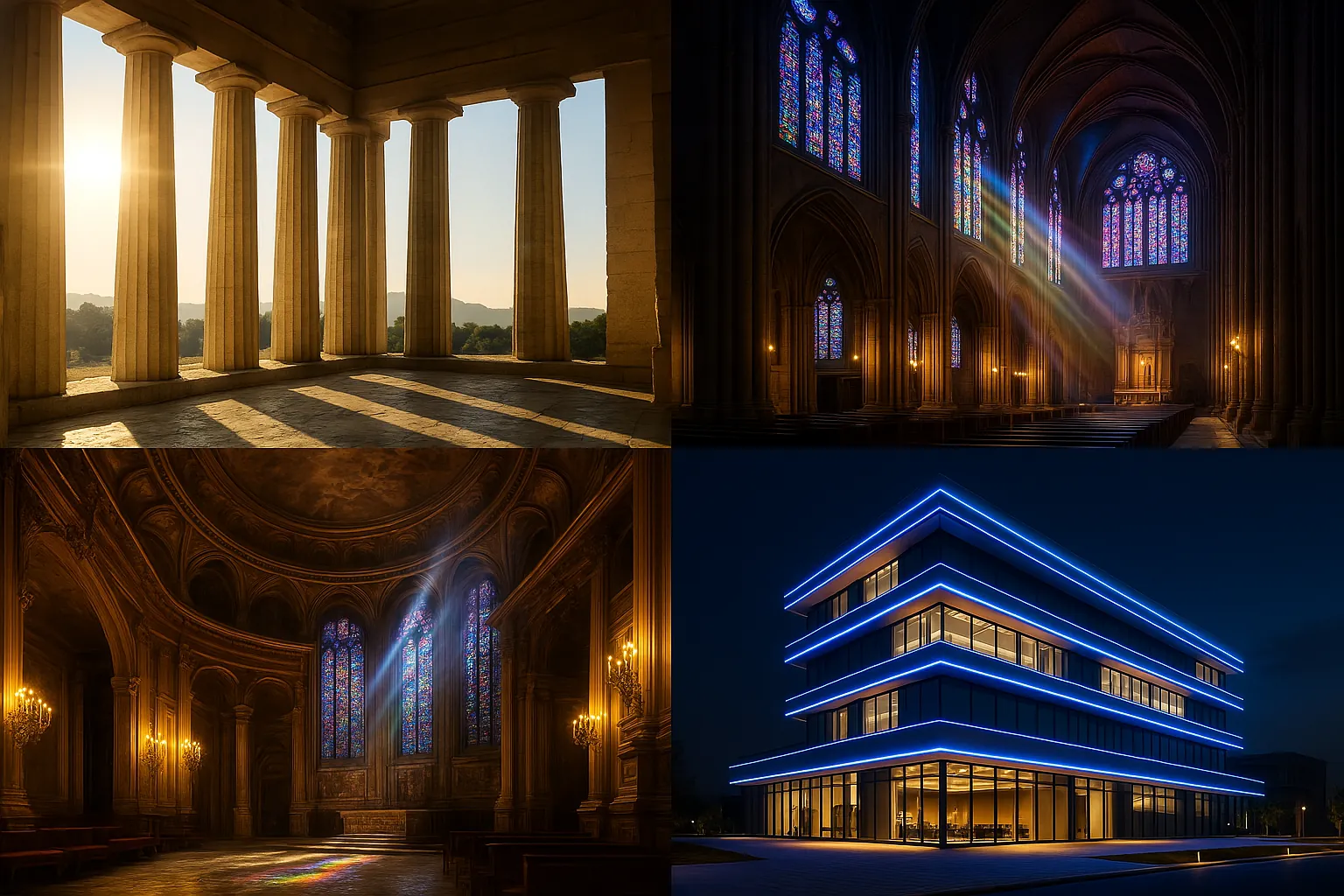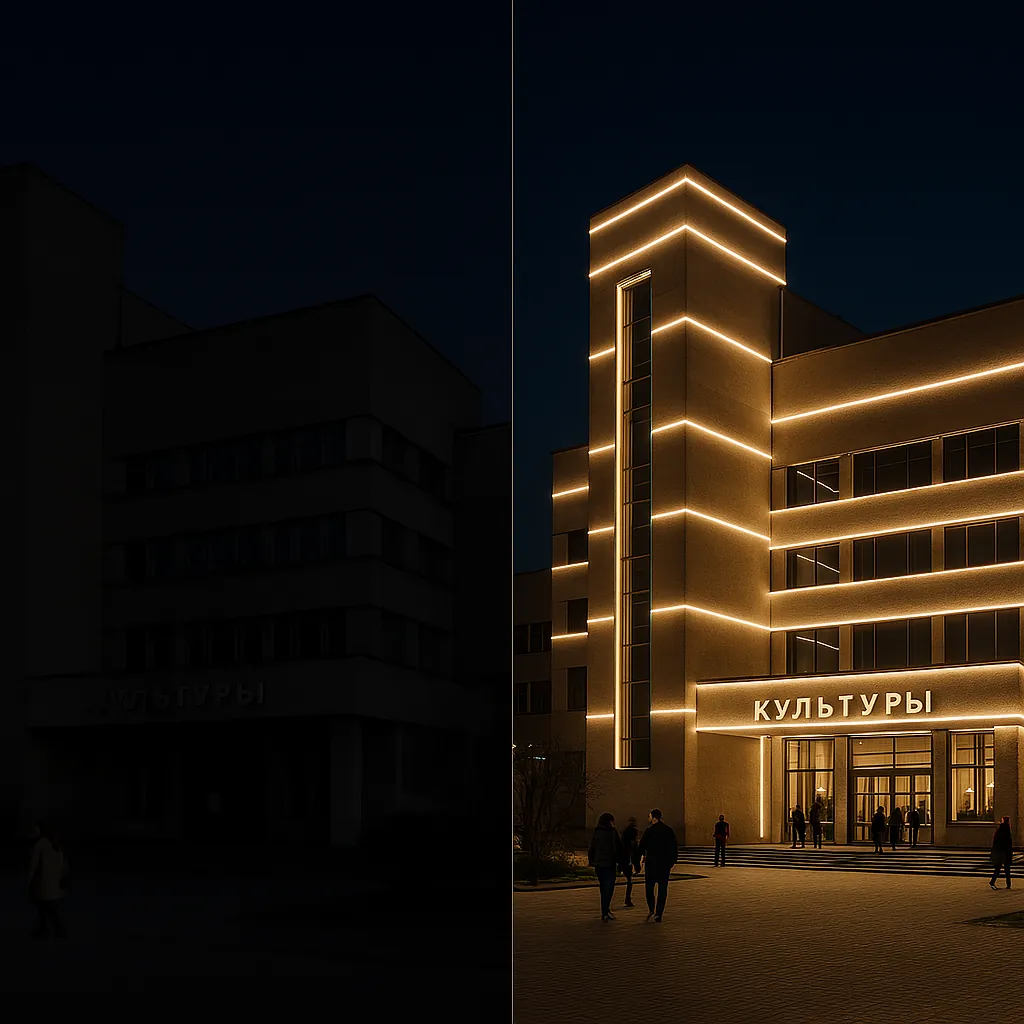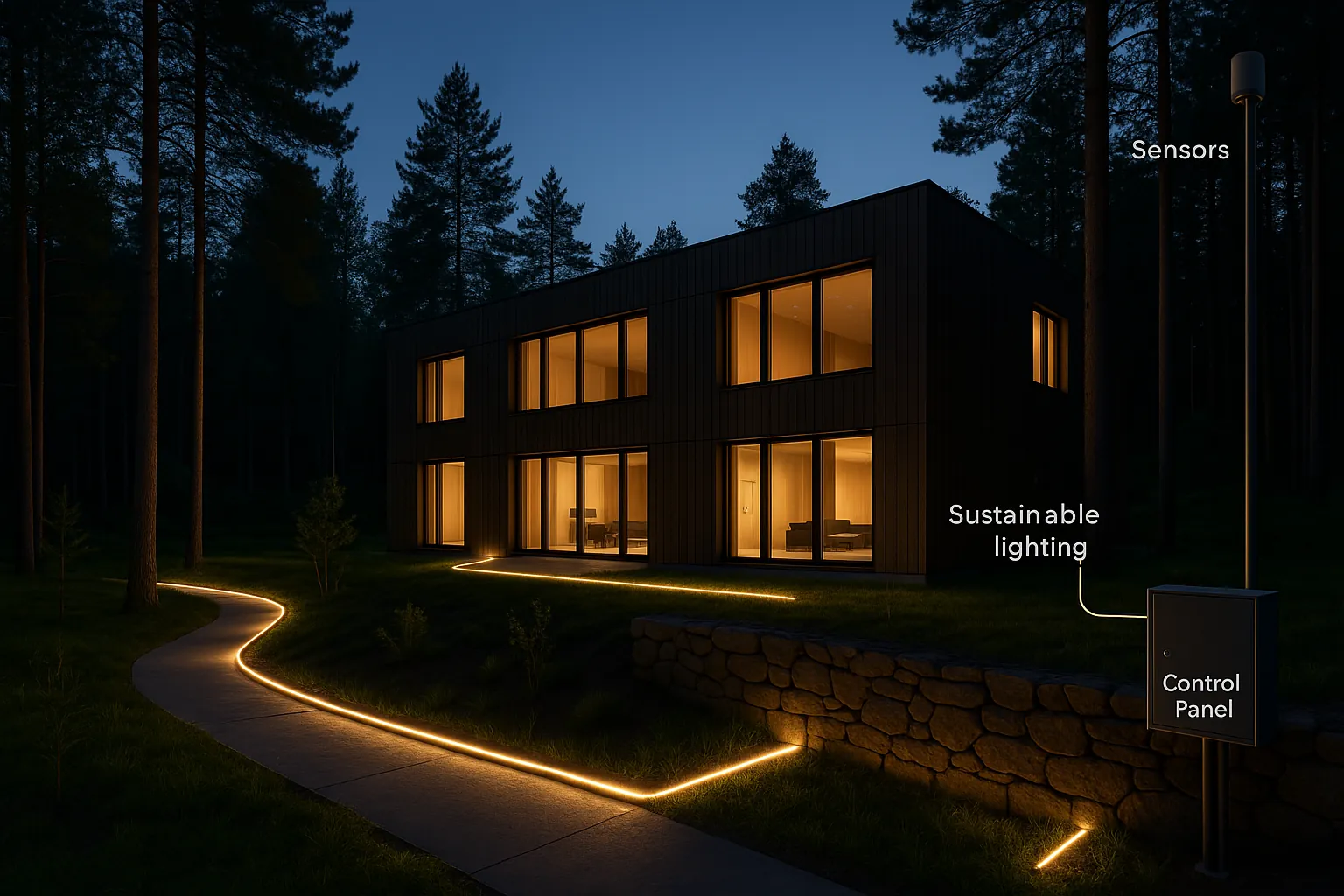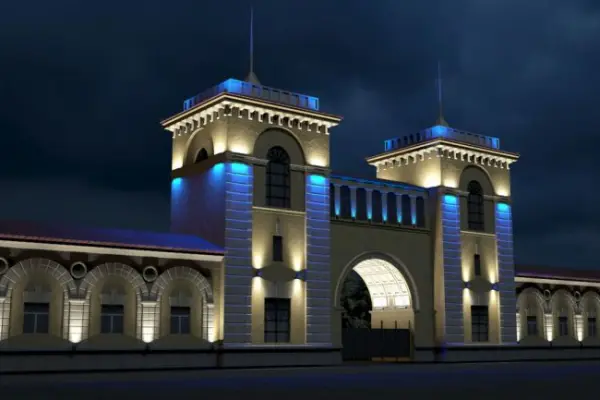In the night cityscape, architectural structures take on a completely new life, transforming into whimsical light compositions. Skillful illumination can not only give a building a magical appearance but also highlight its unique features and enhance the artistic expressiveness of forms. However, harmoniously combining architectural and lighting imagery is a complex task that requires a deep understanding of lighting technology specifics and high professionalism in the field of lighting design.
"Architecture can be compared to a musical composition, and lighting design — to its performance. Even the most brilliant architectural form will remain unnoticed without properly selected lighting that reveals its potential, emphasizes its character, and creates an atmosphere." — Rogier van der Heide, lighting designer
Historical Evolution of Light in Architecture
Throughout the centuries, architects have strived to make their creations impressive not only by day but also at night. The concept of lighting in architecture has evolved from simple functional illumination to complex systems that shape spatial perception. In ancient architecture, natural light was used to create a play of light and shadow on columns and friezes, laying the groundwork for the artistic use of lighting in building design. At each historical stage, light has served different purposes:
The concept of lighting in architecture has come a long way from simple functional light to complex systems that shape spatial perception. At each historical stage, light performed different roles:
- In ancient architecture, natural light was used to create a play of light and shadow on columns and friezes;
- In Gothic architecture, stained glass transformed daylight into colored rays, creating a mystical atmosphere;
- In Baroque, lighting effects enhanced the drama and theatricality of space;
- In modernism, light became a full-fledged architectural element that shapes space.
Nowadays, with advanced technologies at the disposal of lighting designers, the art of lighting design for buildings has reached new heights. Unique opportunities have emerged for implementing bold conceptual solutions that allow buildings to play with completely new colors after sunset, embodying the symbiosis of architecture and lighting.

Relationship Between Architectural and Lighting Imagery
The architectural image of a building is formed at the intersection of the designer's concept, its embodiment in real form, and perception by the end user. While for existing buildings, lighting design can be entrusted to a specialist, when designing new objects, this aspect becomes an integral task of the architect. In modern public buildings, it is necessary to consider how they will be perceived at night, maintaining the intended hierarchy of elements and ensuring visual comfort in architecture.
Lighting technology provides a wide range of tools relatively independent of architectural form: adjustable light intensity, brightness of reflecting surfaces, and other parameters. This allows varying the relationship between architectural and lighting imagery in a wide range of artistic techniques: symmetry, contrasts, proportions, rhythm, etc. However, improper use of light can destroy the integrity of a building's night image, neutralizing the plasticity of forms or disrupting the hierarchy of elements.
"Good architectural lighting – is not just beautiful facade illumination. It's a delicate balance between revealing the building's structure, creating an emotional atmosphere, and integrating the object into the surrounding environment. Light should tell the story of the building, emphasizing its character and purpose." — Jonathan Sperl, founder of an architectural lighting studio
Modern Lighting Technologies in Architecture
Innovative lighting solutions, such as color-changing LED sources, fiber optics, panels, and other light management technologies, significantly expand the palette of lighting tools. Combined with traditional sources, they allow creating effects that go beyond natural lighting. Artificial light can enhance the monolithic nature and volume of architectural form or, conversely, visually fragment it, deepen color shades, and create the illusion of approaching/distancing facade elements.

Modern architectural lighting design uses various techniques for illuminating buildings:
| Lighting Technique | Application Features | Effect | Usage Examples |
|---|---|---|---|
| Contour lighting | Illuminating the building's outlines, highlighting the architectural silhouette | Creates a clear light silhouette, emphasizes the building's shape against the night sky | Burj Khalifa Tower, Dubai |
| Flood lighting | Uniform illumination of the facade using powerful floodlights | Emphasizes the monumentality of the structure, reveals the overall form | The Louvre, Paris |
| Accent lighting | Highlighting individual architectural elements with point light sources | Creates a lighting hierarchy, draws attention to significant details | Sagrada Familia Cathedral, Barcelona |
| Dynamic lighting | Changing color, intensity, and direction of light according to a programmed sequence | Creates an effect of movement and transformation of architectural form | Agbar Tower, Barcelona |
| Tectonic lighting | Emphasizing the main structural elements of the building | Reveals the constructive logic of the building, enhances the perception of tectonics | Centre Pompidou, Paris |
| Light installation | Using light as an independent artistic element | Transforms spatial perception, creates unique visual effects | Art Museum in Singapore |
The choice of appropriate lighting technique depends on the architectural style of the building, its functional purpose, and surrounding context. Professional lighting design takes all these factors into account, creating a harmonious light composition in space.
Leading lighting designers constantly explore new possibilities in architectural lighting. Circadian systems, additive manufacturing, and intelligent light management systems are now at the forefront of innovation. According to experts, modern innovations in lighting design open new horizons for creative expression and functional efficiency.
One effective technique is creating a light silhouette of a building by illuminating finishing elements or using contour linear lighting of the roof/parapet. Also widespread is the «tectonic» method, in which the main structural elements such as columns, arches, pilasters, and other architectural details are highlighted with increased brightness, color, or light-shadow contrast. In this case, the light image is constructed by associative analogy with the daytime perception of architectural form.

Success Story: "Light Transformation of a Cultural Center"
In 2023, a historic House of Culture in St. Petersburg, built in the constructivist style in the 1930s, received new life thanks to innovative lighting design. For decades, the building remained practically invisible in the night cityscape, lost against the background of brightly lit modern buildings.
A team of architectural lighting specialists developed a concept that not only emphasized the constructivist aesthetics of the building but also transformed it into a new landmark of the district. Using a combination of linear LED fixtures to reveal the geometry of the facade and accent lighting to highlight characteristic elements, the designers created a multi-layered light image that reveals the tectonics of the building. A particularly impressive solution was the use of programmable lighting that changes intensity depending on the time of day and season.
The result exceeded expectations – attendance at the cultural center increased by 40%, and the energy consumption of the lighting system turned out to be 60% lower compared to traditional solutions. The project received a prestigious award in the field of architectural lighting and became an example of how thoughtful lighting design can not only emphasize the architectural advantages of a building but also increase its functional value.
Balance of Light and Form
Harmoniously combining architectural and lighting imagery is a complex task that requires consideration of many factors. It is necessary to find a balance between functional expediency, aesthetic expressiveness, and economic efficiency of the solution. Additionally, it is important to adhere to lighting standards for different types of buildings and adjacent territories, avoiding excessive light pollution.
Experienced architects and lighting designers strive to ensure that night lighting does not simply decorate the building but harmoniously complements and enhances its architectural advantages. The light image should emphasize the characteristic features of the object, its style, and conceptual idea, creating a holistic and memorable artistic image.
"Light – is not just a way to make architecture visible at night. It is a tool through which an architect can create different scenarios for perceiving the same space, managing people's emotions and behavior. In the modern world, light architecture is becoming an independent art form, speaking the language of light and shadow." — Maria Karlova, architect and lighting designer
Biophilic lighting design is becoming an increasingly popular approach that takes into account the impact of lighting on human biological rhythms. Circadian lighting systems that mimic natural light contribute to creating a healthy and comfortable environment in building interiors.
Environmental Aspects of Architectural Lighting
In modern architectural lighting design, more and more attention is paid to environmental aspects. Energy-efficient technologies, such as LED lighting and automatic control systems, allow significantly reducing energy consumption without compromising the aesthetic component. Additionally, properly designed architectural lighting systems minimize light pollution, which negatively affects ecosystems and astronomical observations.
Facade lighting strategies increasingly include the following environmental principles:
- Directional lighting that minimizes scattered light
- Use of timers and motion sensors
- Implementation of eco-friendly lighting technologies with low energy consumption
- Consideration of artificial lighting's impact on local flora and fauna
- Application of "smart lighting" technology for energy consumption optimization
 A sustainable approach to architectural lighting is based on several fundamental principles: energy efficiency, maximum use of natural light, conscious choice of materials, accounting for product lifecycle, and ensuring visual comfort. Principles of sustainable lighting not only reduce negative environmental impact but also create healthier, more comfortable, and economically efficient spaces for people.
A sustainable approach to architectural lighting is based on several fundamental principles: energy efficiency, maximum use of natural light, conscious choice of materials, accounting for product lifecycle, and ensuring visual comfort. Principles of sustainable lighting not only reduce negative environmental impact but also create healthier, more comfortable, and economically efficient spaces for people.
The global architectural lighting market was valued at approximately $10.2 billion in 2024 and, according to forecasts, will reach $15.98 billion by 2030, with an average annual growth rate (CAGR) of 7.7%. The most rapid growth is observed in the Asia-Pacific region, where CAGR exceeds 8% — thanks to urbanization and widespread implementation of energy-efficient solutions.
Conclusion
The symbiosis of architecture and lighting represents a unique interdisciplinary field where engineering solutions combine with artistic vision to create impressive visual effects. The harmony of light and form is achieved through a deep understanding of both architectural morphology and lighting design principles. In an era of rapid technological development, professional lighting design becomes an integral part of architectural design, opening new possibilities for expressive design of buildings and urban spaces.
Modern approaches to architectural lighting are not limited to aesthetic aspects but also take into account environmental, economic, and social factors. Integrating lighting design at the early stages of architectural design allows creating harmonious spaces that provide visual comfort and emotional well-being for people.
Recommended Literature in English
- Descottes, H., & Ramos, C. (2021). "Architectural Lighting: Designing with Light and Space." Princeton Architectural Press.
- Narboni, R. (2022). "Lighting the Landscape: Art, Design, Technologies." Birkhäuser Architecture.
- Major, M., Speirs, J., & Tischhauser, A. (2020). "Made of Light: The Art of Light and Architecture." Birkhäuser.
- Zumthor, P. (2019). "Atmospheres: Architectural Environments - Surrounding Objects." Birkhäuser Architecture.
- Branzi, A., & Hale, J. (2023). "Light and Space: Modern Architecture and Contemporary Art." The MIT Press.
- Pallasmaa, J. (2018). "The Eyes of the Skin: Architecture and the Senses." Wiley.
- Ganslandt, R., & Hofmann, H. (2021). "Handbook of Lighting Design." ERCO.
- Millet, M. S. (2019). "Light Revealing Architecture." Wiley.

